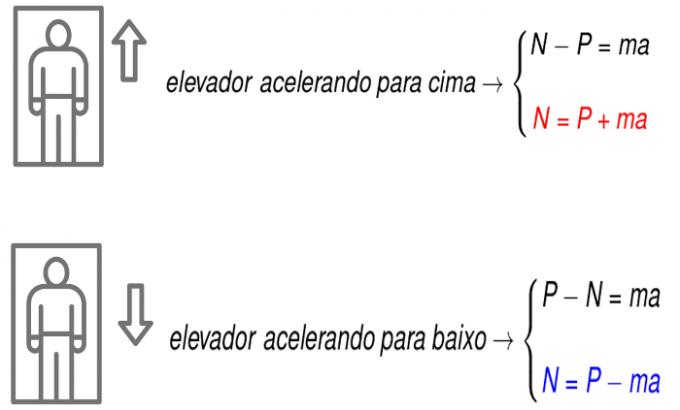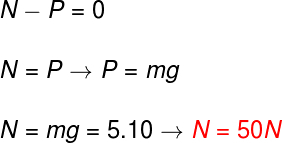Strengthnormal (or simply normal) is the force a surface exerts on an object. When we apply a force to a surface, it will exert a reaction force on us, in the same direction, however with senseopposite. According to the Newton's third law, the normal force must have the same intensity as that applied to the surface, in addition, it is everperpendicular (it makes an angle of 90º) with the plane of this surface.
When any object is placed on a flat surface, the normal force will act in the same direction as your Weight, but with the opposite direction. Thus, the normal force he cancancel yourself with the weight force, causing the body to remain in balance.
Since the normal strength and weight strength act on the same body, they cannot be considered as an action and reaction pair., since, as Newton's third law establishes, these pairs of forces can only exist in different bodies. Below, we will understand the relationship between normal and weight, however, so that you can understand the content of this text more clearly, we suggest that you read about our article: Newton's Laws.

Lookalso:Check out some tips to improve your physics study
normal strength and weight strength
As said, strength weight and normal strength are not action and reaction. Even though these forces always seem to be related, any compression can produce a normal force: when we push a wall, for example, it will exert a normal force on us that is perpendicular to its surface.
It is common to hear that normal and weight are equal and therefore cancel each other out. However, this statement it's not always true. In fact, this is only true for a very specific case: when some object is in balance and supported on a perfectly flat surface, under the exclusive action of the force of weight. Let's check some cases where normal strength is not equal to weight strength:
When any body is supported on an inclined table, the normal force does not correspond to the weight force, but only to its vertical component;
When we find ourselves inside an elevator that performs an accelerated uphill movement, the normal force exerted by the elevator floor will be of greater magnitude than our weight;
When we are in a fast-descending elevator, the normal force will have magnitude less than our weight, similar to when we feel butterflies in our stomachs when we enter a steep descent;
The normal force will be less than the weight force if any of these are pulling an object up. Even if this object remains stationary, the compression it makes on the ground is less.
Lookalso: Understand why we don't feel the Earth rotate
Normal strength formula
There is no specific formula to determine the intensity of normal force acting on a body. However, we know that it will exist whenever a body, under the action of gravity, is supported on some surface. To find the normal force module, it is necessary to assemble a free body diagram, that is, represent the forces acting on the body and correctly represent the normal force as a force that forms a 90º angle with the surface.
Know more:How to Solve Newton's Law Exercises
normal force in plane
The case in which an object is on the plane and under the exclusive action of the simplest weight force is the most common for us to study the normal force, as shown in the following figure:

In the situation illustrated, we see that the weight force and the normal force cancel each other out, so in this case the normal has the same intensity as the body weight.

normal force on the inclined plane
When an object is supported on a surfaceleaning, the compression force it exerts on this surface becomes smaller than if it were horizontal. This happens because the weight force acting on the object breaks down into two, and in this case, the normal force will be canceled only with the vertical component of the weight, as shown in a free-body diagram, in this figure:
![On the inclined plane, the normal equals the y component of the weight. [1]](/f/28bf903d8d23700bc084e56af1f254eb.jpg)
As shown in the figure, the normal force (N) and the y component of the weight (Py) act in the same direction, so we can say that, in this situation, these two forces cancel each other out, so the normal is equivalent to Py:

normal force in elevator
when we are in a elevator at rest or even going up or down with constant speed, the normal will be exactly equal to our weight. However, if the elevator is being accelerated in any direction (up or down), the normal may be smaller or larger than our weight, as shown in the following figure:

According to the application of Newton's second law, the resulting force on the elevator occupant in each case will determine how much greater or lesser the magnitude of normal force will be. To find the result in each of the situations, we apply this law.
normal strength work
If any body supported on a horizontal surface moves on a directionparallel to that surface, the normal force acting on it will do no work.. This is due to the fact that the normal force is always formed at an angle of 90° to the surface. As we know, the definition of work done by a force says that forces perpendicular to displacement are not capable of doing work, as shown in this formula:

normal strength and the scale
when we step on a scale we are not measuring our weight, much less our mass, at least not directly. If we were measuring any of these magnitudes, the scale would not show any change in its measure if someone were to lean on our shoulders, for example.
What the scale actually measures is the normal force exerted by it, for this, the most common scales are equipped with springs properly calibrated. When pills, these springs deform, and it is based on this deformation that, at least indirectly, our mass is measured.
Lookalso: Discover some discoveries in Physics that occurred by accident
Solved Exercises on Normal Strength
Question 1) In relation to normal force, check the alternative incorrect:
a) Normal force is always perpendicular to the surface.
b) Normal force appears as a reaction to the weight of a body resting on a surface.
c) Normal and weight are not an action and reaction pair.
d) Normal force is proportional to the force with which an object compresses a surface.
e) Normal strength will not always have modulus equal to weight strength.
Template: Letter B
Resolution:
The only incorrect alternative on the list is the letter B, because the normal force is not a reaction force to the weight force. In fact, the normal force is a compressive reaction force that is placed on a surface.
Question 2) A 5 kg body is supported on a flat surface, in a place where gravity equals 10 m/s². Determine the intensity of the normal force acting on that body.
a) 50 N
b) 2 N
c) 20 N
d) 2.5 N
e) 25 N
Template: Letter a
Resolution:
It is enough to remember that when an object is in equilibrium and supported on a horizontal surface, the normal force acting on it is of an intensity equal to its weight. Check the calculation:

Question 3) A body with a mass equal to 5 kg is supported on an inclined, smooth, frictionless surface. Knowing that the angle of inclination of the surface in relation to the horizontal direction is equal to 30°, determine what is the intensity of the normal force acting on this body.
a) 50 N
b) 150 N
c) 6 N
d) 25 N
e) 15 N
Template: Letter D
Resolution:
As stated in the text, when a body is supported on an inclined surface, its normal will correspond to the vertical component of its weight (Py). This weight component can be calculated by multiplying the weight by the cosine of the slope angle. Knowing that the angle in this case is 30º and that the cos 30º is equal to 0.5, it is necessary that we do the following calculation:

Analyzing the calculation made, we can see that, for when the angle of inclination of the plane is 30º, the intensity of the force normal drops by half the value it would have if the object were resting on a surface aligned with the direction horizontal.
By Me. Rafael Helerbrock

